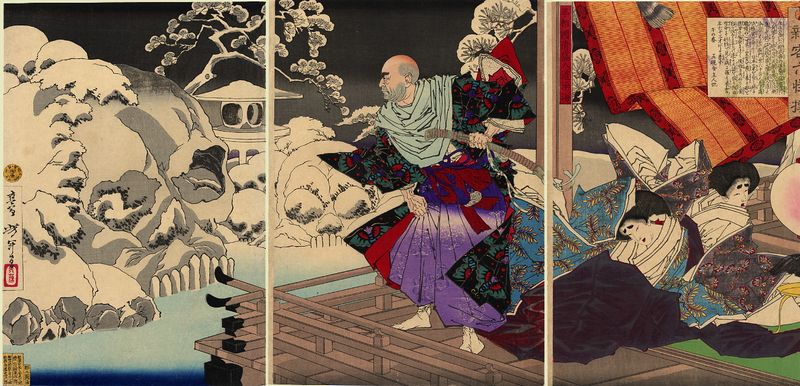105973, Киёмори - картины 17-19 веков
Послано guest, 03-08-2013 19:32
http://commons.wikimedia.org/wiki/Category:Taira_no_Kiyomori

Tsukioka Yoshitoshi, The Fever, August 1883. Triptych, 28.25" by 13.75". The print depicts Kiyomori, suffering from fever, as he confronts Enma, the king of hell, and the ghosts of Kiyomori's victims. - Киёмори, страдающий от лихорадки, перед ним Энма, царь ада, и призраки жертв тиранства Киёмори.

Tsukioka Yoshitoshi. From the series, 'A New Selection of Strange Events'. Taira no Kiyomori sees the skulls of his victims. 1882 - Киёмори видит черепа жертв в заснеженном саду - т.е. речь о северной стране. И возможно это надо понимать как раскаяние Грозного после опричнины?

Hiroshige Utagawa, Taira no Kiyomori ve apariciones sobrenaturales (1840).

Gio and Hotoke by Chikanobu (1838 - 1912)
Comments - Intriguing scene from the story of Gio and Hotoke as told in the "Heike Monogatari." Gio was a popular shirabyoshi dancer and a special favorite of Taira no Kiyomori. When Kiyomori fell in love with a new and younger dancer named Hotoke gozen, Gio was forced to retire against her will, becoming a nun along with her sister and mother. Here, the stern-looking Kiyomori grasps Hotoke gozen by the hand. She turns her head away in guilt, hiding her face with her sleeve as Gio bows respectfully behind her, two child attendants at her side. The verandah overlooks a beautiful garden pond with a small waterfall and bridge. The palace stretches out along the right, crowded with samurai attending a party in the back. Two children kneel beside a set of burnished black lacquer steps at right, waiting for the daimyo to pass by. In the end, the guilt-ridden Hotoke became a nun as well, and forgiven by Gio, the four women served their days out together in prayer. Beautifully drawn with wonderful detail in the sumptuous fabrics and setting. A handsome image with delicate embossing in the white kimono collars.
http://www.fujiarts.com/cgi-bin/item.pl?item=207422
- Гио и Хотокэ - отражение истории Есфири? Слева Гио, в центре Хотокэ в противоречивых чувствах (а Есфирь падала в обморок перед Артаксерксом).
http://honolulumuseum.org/art/6196-the-story-of-gia-hotoke-gozen-dancing-before-kiyomoria_z
Suzuki Harunobu. The Story of Giö (Hotoke-gozen) : Dancing Before Kiyomori, c. 1765
Description: This print depicts a scene from the story of Giö. Giö was a beautiful dancer in Kyoto favored by Taira no Kiyomori, the most powerful samurai in the 12th century. However, one day a prominent younger dancer, Hotoke-gozen, appeared at Kiyomori's mansion and danced for him. As a result, Giö was replaced by Hotoke-gozen. At the end of the story, both dancers abandon this transient world (romantic love, in particular) and take holy vows. In this scene, Hotoke-gozen dances in the presence of Kiyomori and Giö. The delicate and tender depictions of the girls are reminiscent of Sukenobu's works, as seen on the left-hand side. (from Kamigata-e exhibition 4/1/2008-)
- Хотокэ танцует перед Киёмори и Гио. Казалось бы, что здесь особенного, какой-то правитель заменил одну танцовщицу другой. И тем не менее почему-то этому сюжету придавалась значимость, писались картины - видимо, это было значимое событие, возможно, это 'история Есфири-Елены' при дворе 'Ивана Грозного'. Но почему именно танец? Вспоминается танец Саломеи перед Иродом, который тоже неправедно женился на жене "брата" Иродиаде.
http://dbs.humi.keio.ac.jp/naraehon/ehon/index2-e.asp?ID=KL019&FRAME=False
Title: Gio
Time: Beginning of Edo Period (1600-1640)
|



